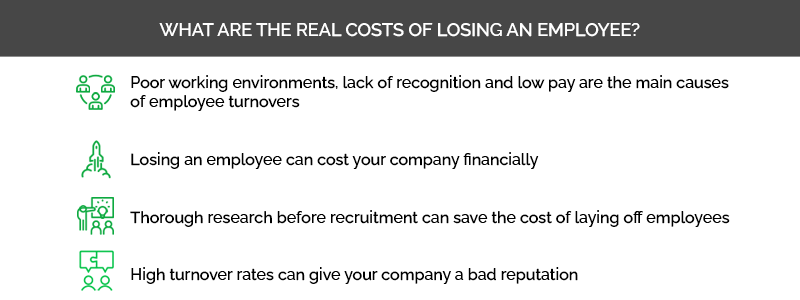What Are the Real Costs of Losing An Employee?


Losing an employee, especially a productive one, can leave you unhappy. But what is the actual cost of employee turnover? Read this guide for answers.
Employees are leaving their jobs in record numbers. According to data from the Bureau of Labor Statistics, the percentage of employee turnover in the United States reached a frightening 57% in 2021. For comparison, the employee turnover rate was 26.3% in 2017.
Losing an employee can hurt, especially if that person was key to your operations. In this post, we dig into the full costs of losing employees. We’ll also explain how to combat high turnover rates.
1. Financial losses
Financial losses are a significant concern with employee turnover. Replacing an employee requires recruitment and training, which could cost you almost double the employee's salary. Sometimes, you'd even have to pay another employee extra to assume the vacant position.
These costs may vary depending on your mode of operation. For example, with recruitment, the cost of interviewing candidates, conducting background research, posting job vacancies, receiving applications, and conducting training sessions may heavily impact your company’s resources. In some cases, you may need to absorb the cost of relocating recruits.
You might also have to pay severance or other compensation when you lay off a worker. The extent of such pay depends on the employee's position and work output. Nonetheless, these costs add up.
Once you’ve replaced a quality employee, it will take substantial training for a new employee to learn the ropes. Training sessions typically carry considerable cost.
2. Decreased productivity
When an employee leaves, their work is either left undone or transferred to other employees. Either way, there’s a decline in productivity.
Transferring roles to other employees equals more workload, leaving them stressed and overwhelmed due to picking up the slack work. They’re also expected to meet the same targets as before, even though there are now fewer workers.
Stressed employees aren't going to deliver as expected; they’ll have to spread themselves thin across many roles, and this may affect your company’s productivity. Leaving the projects unattended may also cause your business to run the risk of not meeting targets and losing customers.
3. Low employee morale
Low morale among employees is another cost of losing staff. Having a work friend boosts work motivation and healthy work habits. When that friend leaves, enthusiasm can go down a notch.
Since work morale is contagious, you may begin to see a lack of innovation and inspiration among other employees. If your star performer leaves the company, the others begin to question themselves. What made this person go? Should I consider leaving also? These thoughts may dampen their enthusiasm, and that’s a high cost to your organization.
4. Knowledge gaps
When a veteran worker leaves, your company will likely suffer. Such employees often have institutional knowledge that might take another employee several years to gain.
While a new hire might be smart and skilled, they’ll take time to gain the same experience and knowledge about your business’s operations. That's why employee retention is essential.
5. Diminished company image
Word gets around. If your company is known for losing employees, it only attracts individuals who may not be willing to commit to the job long-term. These people may negatively impact other employees and drive them to exit.
In addition, you may not get talented employees. The best workers always want to work in companies that match their desire and ambition. If your company has top workers leaving in droves, it will be hard to get quality replacements.
But that’s just a tip of the iceberg. Many customers may shy away from doing business with you if you have a reputation for losing top employees. It may signal that all’s not well within your company.
MetaGrowth can help
Tackling employee turnover starts with recruitment. You need to hire employees who will believe in your vision and adopt your company culture. It’s crucial to provide consistent training and coaching for your employees.
Fortunately, you don’t have to do it by yourself. MetaGrowth can help you hire, train, and manage world-class sales teams. Out two founders will bring over 30,000 hours of coaching and consulting experience to your company. Get in touch to see how we can help you keep your employees or hire new ones.
Written by
Joe Arioto
